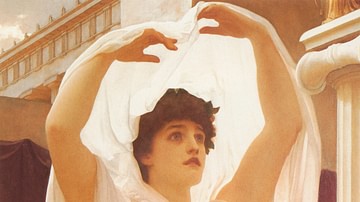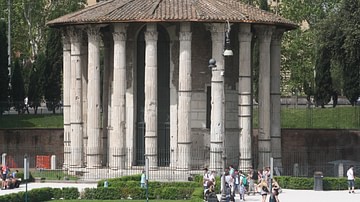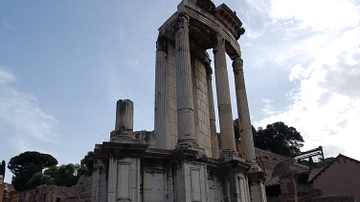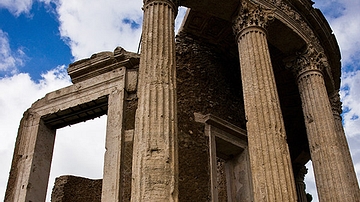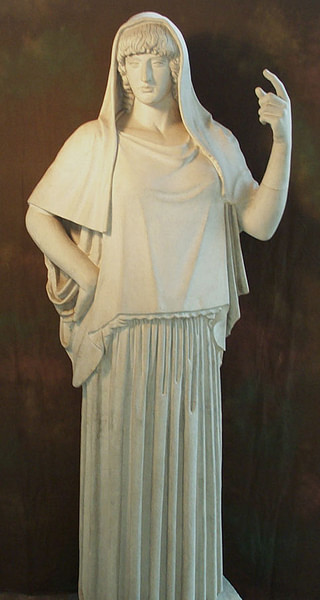
Hestia was the Greek virgin goddess of the hearth, home, and hospitality. In Greek mythology, she is the eldest daughter of Cronus and Rhea. In her role as a protector of the family and political community, sacrifices and offerings were regularly made to Hestia at the hearth within each private home and at the town or city's public hearth. To the Romans, the goddess was known as Vesta.
Family
In the Greek myths, Hestia's parents were Cronus and Rhea and so her younger siblings were Zeus, Hera, Demeter, Poseidon, and Hades. Cronus, paranoid that one of his own children would overthrow his rule, swallowed them all. Zeus, however, was saved by his mother when she gave her husband a rock wrapped in cloth instead of the infant who later returned and made his father cough up his siblings. Hestia never married and remained a virgin, despite the amorous attentions of Apollo, Poseidon, and Priapus, the fertility god.
The Greek goddess was the only one to not join the Olympians in their failed attack on Zeus. In some lists, Hestia is one of the 12 Olympian gods but more commonly her place is taken by Dionysos. In some myths the goddess voluntarily relinquishes her place amongst the gods on Mount Olympus, swapping with Dionysos because she prefers to withdraw from godly affairs and is sure of a fond welcome in any mortal city she chooses. Being a somewhat housebound god, Hestia does not get into any entertaining adventures in Greek mythology, rather, she seems to have taken the role of a senior goddess aloof from the other gods and their all-too-human weaknesses.
The Hearth in Greek Culture
The goddess was the personification of the hearth and so she received sacrifices in all the temples of the gods as each one had its own hearth. By tradition, Hestia received any sacrifices before the other gods, even at such places as Olympia where Zeus was honoured. Hestia also received the first and last libations of wine offering at any feast and was usually mentioned first in any prayers and oaths. For this reason, there developed a saying 'to begin from Hestia.' In mythology, the honour of receiving the first sacrifice was given by Zeus when Hestia swore that she would always remain a virgin.
Within a Greek house, the hearth was usually a portable brazier but it symbolised the heart and soul of the household and came to represent its centre. The hearth was thus the focal point for many activities, not just cooking. A birth ceremony involved carrying the baby around the hearth, brides and slaves new to the household were showered in nuts and figs before it, and following the death of a family member, the hearth might be put out and relit again (a practice common in Argos). At everyday meals, a token offering might also be made to Hestia by throwing it into the hearth. The goddesses personification as the hearth also linked her to ideas of hospitality, the protection of guests, and the inventor of good housebuilding.
Besides individual homes, Hestia was particularly associated with the prytaneion and bouleuterion, the symbolic centre of a town or city where civic functions were held and the business of local government was carried out. Here there was usually a hearth which was a tradition dating back to Mycenaean Greece when the king's throne and reception room in his palace, the megaron, had a large hearth. The later town's hearth was continuously maintained by the community, typically by unmarried women selected for that purpose. The goddess received sacrifices at this communal hearth each time a new magistrate began and ended their term of office and before council sessions. Curiously, following the failed invasion of Greece by the Persians in the 5th century BCE, Delphi - in many ways the religious heart of the Greek city-states - ordered that all communal hearths be extinguished because they were now considered impure. The hearths were then relit using purified flames taken from the hearth at Delphi.
Cults to the Goddess
Public worship of Hestia was especially prevalent in Attica with notable cults at Piraeus, Eleusis, Halimos, and Krokonidai. Some cults, for example at Naukratis and Kos, forbade women to participate in rituals related to Hestia at the communal hearth due to its connection with the political life of the city (which only men could participate in). Priests and priestesses specifically dedicated to Hestia seem to have been particularly prevalent from the Hellenistic period. In the Roman period, Hestia, now known as Vesta, continued to be worshipped, for example at Ephesus where the high priest was a female.
Hestia in Art
As Hestia has no particular mythology surrounding her, she does not appear very often in Greek art, and when she does, she can be difficult to distinguish from other goddesses, especially as she does not carry an easily identifiable object associated with her. She is usually presented as a young female wearing a head covering and modest clothing, and sometimes she is pouring a libation, as in a c. 500 BCE red-figure kylix now in the Berlin Staatliche Museen which shows her in the company of Apollo and Hermes as they lead Hercules to Mount Olympus.
She appears on the celebrated Francois Vase (570-565 BCE) and, this time named, on the north frieze of the Siphinian Treasury at Delphi (c. 525 BCE) where she and an unidentified goddess face two giants in hoplite uniform. Hestia may be a seated figure in the group from the east pediment of the Parthenon, but the marble statue is incomplete and so it is difficult to identify with certainty. Another possible appearance is the so-called 'Hestia Giustiniani' - a standing female with a veiled head and suitably austere peplos dress - but this could also be Hera or Demeter. The figure, standing 1.9 metres (6.2 ft) tall, is a copy of an original made around 470 BCE and can be seen at the Villa Albani in Rome.


